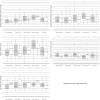Is recovery just the beginning? Persistent symptoms and health and performance deterioration in post-COVID-19, non-hospitalized university students-a cross-sectional study
- PMID: 38144461
- PMCID: PMC10739555
- DOI: 10.1093/biomethods/bpad037
Is recovery just the beginning? Persistent symptoms and health and performance deterioration in post-COVID-19, non-hospitalized university students-a cross-sectional study
Abstract
Many individuals experience persistent symptoms such as deteriorated physical and mental health, increased fatigue, and reduced cognitive performance months after recovering from coronavirus disease 2019 (COVID-19). There is limited data on the long-term trajectory and prevalence of these symptoms, especially in milder cases. Our study aimed to assess the persistent effects of COVID-19 on physical and mental health, fatigue, and cognitive performance in a cohort of 214 students, averaging 21.8 years of age. Of these, 148 had contracted COVID-19 but were not hospitalized, with the time since infection ranging from 1 to 39 months. We utilized a comprehensive panel of cognitive tests to measure intelligence, memory, and psychomotor skills, and a detailed anamnestic questionnaire to evaluate physical and mental health. While contracting COVID-19 did not significantly impact overall health and performance, it was associated with increased reports of fatigue. However, the reported severity of the disease had a pronounced negative influence on physical health, mental well-being, fatigue, and reaction time. Trends of improvement in physical and mental health, as well as error rate, were observed within the first 2 years post-infection. However, fatigue and reaction time showed a trend of deterioration. Beyond the 2-year mark, physical health and error rate continued to improve, while mental health began to deteriorate. Fatigue and reaction time continued to decline. Overall, our findings suggest that some effects of contracting COVID-19 can persist or even deteriorate over time, even in younger individuals who had mild cases that did not require hospitalization.
Keywords: COVID-19; SARS-CoV-2; cognitive performance; fatigue; long COVID; long-term effects; mental health; physical health; post-COVID sequelae.
© The Author(s) 2023. Published by Oxford University Press.
Conflict of interest statement
The authors declare no competing interests.
Figures



Similar articles
-
Persistent Health and Cognitive Impairments up to Four Years Post-COVID-19 in Young Students: The Impact of Virus Variants and Vaccination Timing.Biomedicines. 2024 Dec 30;13(1):69. doi: 10.3390/biomedicines13010069. Biomedicines. 2024. PMID: 39857653 Free PMC article.
-
Fatigue and Mental Illness Symptoms in Long COVID: Protocol for a Prospective Cohort Multicenter Observational Study.JMIR Res Protoc. 2024 Jan 19;13:e51820. doi: 10.2196/51820. JMIR Res Protoc. 2024. PMID: 38241071 Free PMC article.
-
Severe Fatigue in Long COVID: Web-Based Quantitative Follow-up Study in Members of Online Long COVID Support Groups.J Med Internet Res. 2021 Sep 21;23(9):e30274. doi: 10.2196/30274. J Med Internet Res. 2021. PMID: 34494964 Free PMC article.
-
Assessment of the Frequency and Variety of Persistent Symptoms Among Patients With COVID-19: A Systematic Review.JAMA Netw Open. 2021 May 3;4(5):e2111417. doi: 10.1001/jamanetworkopen.2021.11417. JAMA Netw Open. 2021. PMID: 34037731 Free PMC article.
-
Post-viral fatigue in COVID-19: A review of symptom assessment methods, mental, cognitive, and physical impairment.Neurosci Biobehav Rev. 2022 Nov;142:104902. doi: 10.1016/j.neubiorev.2022.104902. Epub 2022 Oct 3. Neurosci Biobehav Rev. 2022. PMID: 36202253 Free PMC article. Review.
Cited by
-
Persistent Health and Cognitive Impairments up to Four Years Post-COVID-19 in Young Students: The Impact of Virus Variants and Vaccination Timing.Biomedicines. 2024 Dec 30;13(1):69. doi: 10.3390/biomedicines13010069. Biomedicines. 2024. PMID: 39857653 Free PMC article.
-
Persistent symptoms and clinical findings in adults with post-acute sequelae of COVID-19/post-COVID-19 syndrome in the second year after acute infection: A population-based, nested case-control study.PLoS Med. 2025 Jan 23;22(1):e1004511. doi: 10.1371/journal.pmed.1004511. eCollection 2025 Jan. PLoS Med. 2025. PMID: 39847575 Free PMC article.
-
Research evidence on the management of the cognitive impairment component of the post-COVID condition: a qualitative systematic review.Eur Psychiatry. 2024 Sep 27;67(1):e60. doi: 10.1192/j.eurpsy.2024.1770. Eur Psychiatry. 2024. PMID: 39328154 Free PMC article.
-
Long-term cognitive and autonomic effects of COVID-19 in young adults: a cross-sectional study at 28 months.Ann Med. 2025 Dec;57(1):2453082. doi: 10.1080/07853890.2025.2453082. Epub 2025 Jan 16. Ann Med. 2025. PMID: 39819240 Free PMC article.
-
COVID's long shadow: How SARS-CoV-2 infection, COVID-19 severity, and vaccination status affect long-term cognitive performance and health.Biol Methods Protoc. 2023 Dec 7;8(1):bpad038. doi: 10.1093/biomethods/bpad038. eCollection 2023. Biol Methods Protoc. 2023. PMID: 38130975 Free PMC article.
References
-
- Fernández-de-Las-Peñas C, de-la-Llave-Rincón AI, Ortega-Santiago R. et al. Prevalence and risk factors of musculoskeletal pain symptoms as long-term post-COVID sequelae in hospitalized COVID-19 survivors: a multicenter study. Pain 2022;163:e989–e996. - PubMed
-
- Santos RAG, Rodríguez MSR, Hernandez D. S. L. & Neurological manifestations in COVID-19 survivors: Observations in one of the largest only COVID-19 centers in México. (P5-10.003). 2023 AAN Annual Meeting Scientific Abstracts P5-10.003, American Academy of Neurology, Minneapolis, Minnesota, 2023.
Associated data
LinkOut - more resources
Full Text Sources
Miscellaneous
